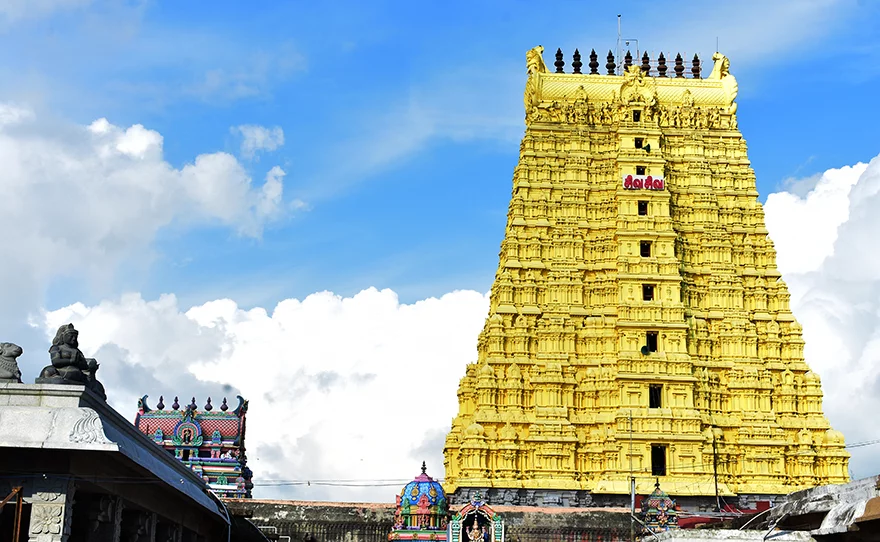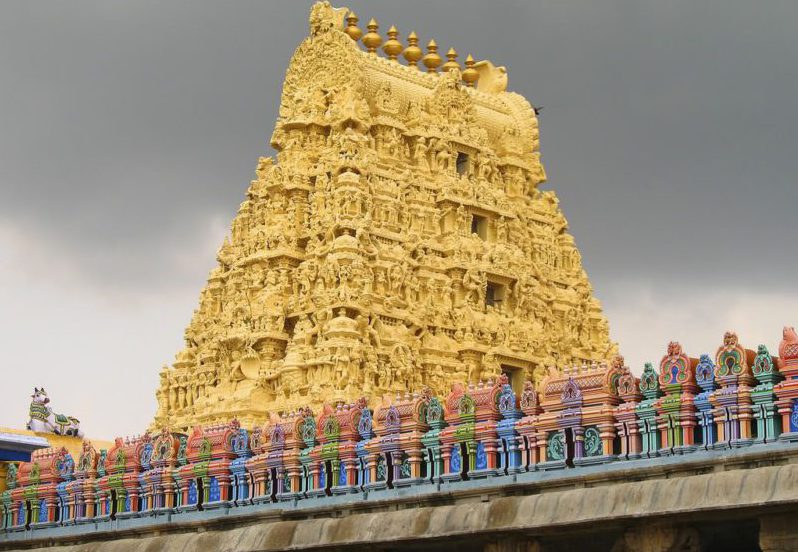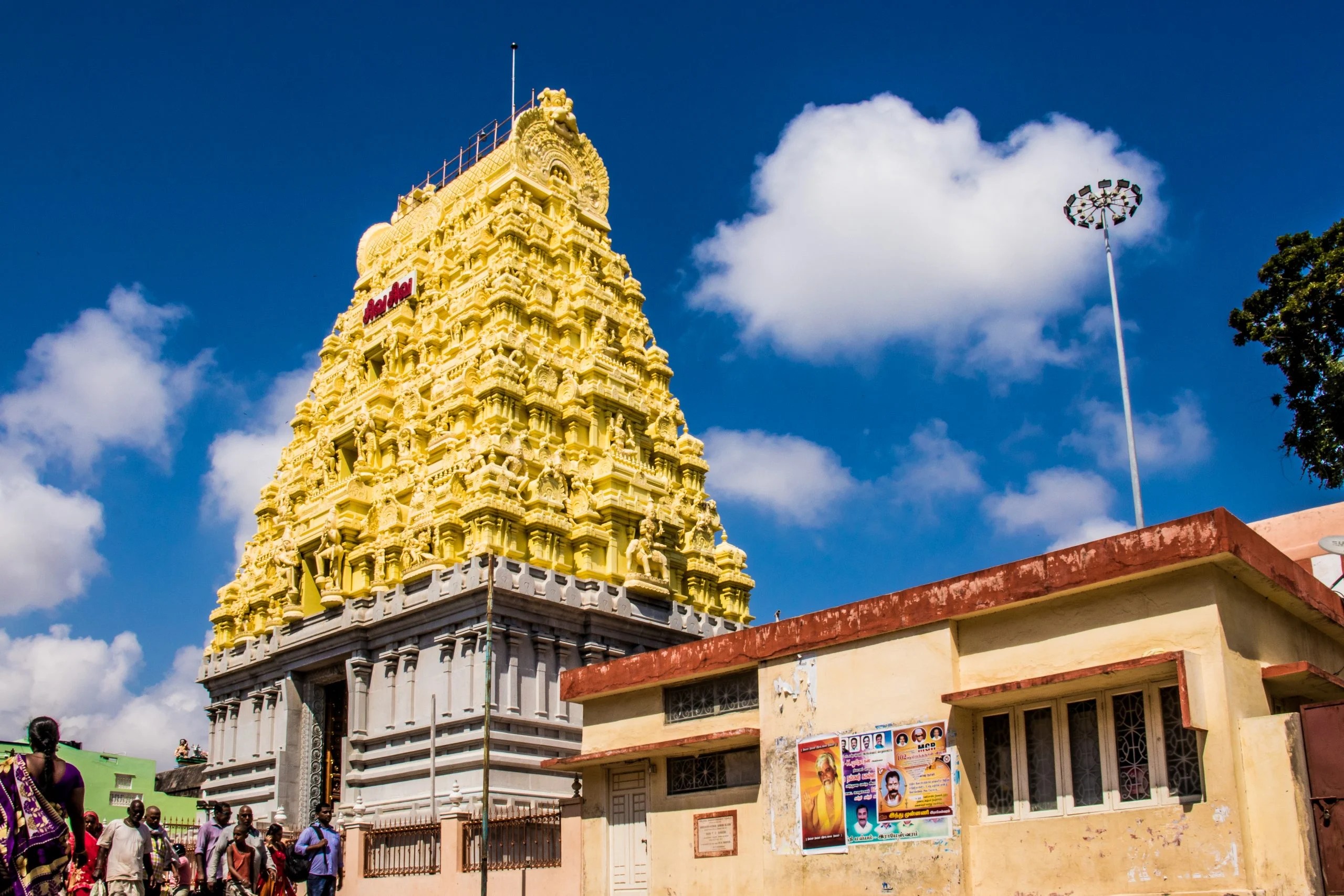The Ramanathaswamy Temple, also known as the Rameshwaram Temple, is one of the most famous and significant Hindu temples in India. It is located on Rameswaram Island in Tamil Nadu, in the southern part of the country. The temple is dedicated to Lord Shiva and is an important pilgrimage site for Hindus, particularly for those who believe in the Char Dham pilgrimage, which includes Rameswaram as one of the four sacred destinations.

Key features and facts about the Rameshwaram Temple:
-
Historical Significance: The Rameshwaram Temple is renowned for its historical and mythological significance. It is believed to have been established by Lord Rama himself, the central character of the Indian epic Ramayana. According to the legend, Lord Rama prayed to Lord Shiva at this spot to seek blessings before his battle with Ravana, the demon king of Lanka.
-
Architecture: The temple is an architectural marvel and is known for its impressive Dravidian style of architecture. It features a long corridor with sculpted pillars, intricate carvings, and a large gopuram (tower) at the entrance.
-
Corridors and Tanks: One of the unique features of the temple is the long corridors with 1,212 intricately carved pillars. It also has 22 sacred wells or “tanks” within the complex. Bathing in these tanks is considered a purifying ritual by pilgrims.
-
The Holy Lingam: The temple’s primary deity is a Shiva Lingam, known as the Ramanathaswamy Lingam. It is believed to be one of the twelve Jyotirlingas, which are sacred representations of Lord Shiva.
-
Agnitheertham: The temple is located near the shores of the Bay of Bengal. Pilgrims often take a ritual bath in the sea at a place called Agnitheertham before entering the temple.
-
The Floating Stone: Inside the temple, there is a unique structure known as “Sethu Karai” or the floating stone. According to mythology, this stone was used to build the bridge to Lanka (now Sri Lanka) by Lord Rama’s army.
-
Rama Navami: Rameshwaram Temple celebrates the birth of Lord Rama with great enthusiasm during the festival of Rama Navami. Thousands of devotees visit the temple during this time to participate in the celebrations.
-
Religious Significance: The temple is not only significant for Hindus but also holds importance for people of other faiths. It is a place where devotees come to perform ancestral rites, seeking salvation for their deceased ancestors.
-
Visiting Information: The temple is open to all, but there are certain dress code and entry rules that need to be followed. Pilgrims often circumambulate the island before entering the temple as a mark of respect.
The Rameshwaram Temple is not only a place of worship but also a symbol of India’s rich cultural and religious heritage. It attracts tourists and pilgrims from all over the world who come to witness its grandeur, spirituality, and historical significanc
Table of Content
History
The Ramanathaswamy Temple, also known as the Rameshwaram Temple, is one of the most famous and sacred Hindu temples in India. Located on Rameswaram Island in Tamil Nadu, it is dedicated to Lord Shiva. The temple is not only renowned for its religious significance but also for its historical and architectural importance.
Here’s a brief history of the Rameshwaram Temple:
-
Legend of Rameshwaram: According to Hindu mythology, Rameswaram is closely associated with the epic Ramayana. Lord Rama, an avatar of Lord Vishnu, is believed to have built a bridge, known as “Rama Setu” or “Adam’s Bridge,” from the island of Rameswaram to Sri Lanka to rescue his wife Sita from the demon king Ravana. Rameswaram is said to be the place where Lord Rama prayed to Lord Shiva to seek his blessings before embarking on this mission.
-
Construction and Expansion: The exact date of the temple’s construction is not clear, but it is believed to have been built during the 12th century by Pandya Dynasty rulers. Over the centuries, various rulers and dynasties, including the Chola and Sethupathi Kings, contributed to the expansion and renovation of the temple. The temple’s architecture reflects the Dravidian style and has intricate carvings and colorful gopurams (towering entrance gates).
-
The Corridor: One of the most distinctive features of the Rameshwaram Temple is its impressive 1,000-pillared corridor, which is renowned for its architectural beauty. Each pillar is intricately carved and has sculptures depicting various mythological stories.
-
Jyotirlinga: The temple is home to one of the 12 Jyotirlingas (shrines) dedicated to Lord Shiva, which are considered the most sacred shrines for Shaivites. The lingam (a symbolic representation of Lord Shiva) in the sanctum sanctorum is believed to have been consecrated by Lord Rama himself.
-
Religious Significance: Rameswaram is a prominent pilgrimage site for Hindus. It is believed that a pilgrimage to Rameswaram and a bath in the sacred waters of Agni Theertham can cleanse one’s sins. The temple is visited by thousands of devotees and tourists every year.
-
Historical Events: The temple has seen its share of historical events. In 1964, it was the site of a major controversy during the installation of a deity of Lord Rama, which was removed after a legal dispute. This led to a period of unrest and subsequent reinstallation.
The Rameshwaram Temple stands as a symbol of rich Hindu heritage, architecture, and religious significance. It continues to attract devotees and tourists from all over the world who come to seek blessings, marvel at its architectural beauty, and explore the history and legends associated with this sacred site.
Yearly Festivals
Rameshwaram, a town located on Pamban Island in the southern part of India, is famous for its historic Ramanathaswamy Temple. This temple is one of the twelve Jyotirlinga temples and is considered a holy pilgrimage site for Hindus. Throughout the year, the temple hosts various festivals and rituals, some of which are celebrated annually. Here are some of the yearly festivals celebrated at Rameshwaram Temple:
- Maha Shivaratri: Maha Shivaratri is one of the most significant festivals in Rameshwaram. It is dedicated to Lord Shiva and usually falls in February or March. Devotees fast, offer prayers, and perform special rituals during this festival.
- Panguni Uthiram: This festival occurs in the Tamil month of Panguni (March-April) and is dedicated to Lord Rama. The highlight of the festival is the grand procession of deities around the temple.
- Navaratri: Navaratri is a nine-night festival dedicated to the Goddess Durga, also known as the Divine Mother. It typically falls in September or October, and the temple is adorned with colorful decorations and lights during this time.
- Ram Navami: Ram Navami is celebrated to mark the birth of Lord Rama. Devotees visit the temple to offer their prayers and seek the blessings of Lord Rama.
- Adi Amavasya: Adi Amavasya is a special day for ancestor worship. It usually falls in July, and people offer prayers for their ancestors’ souls to rest in peace.
- Thai Amavasya: Thai Amavasya is celebrated in the Tamil month of Thai (January-February). On this day, devotees take a holy dip in the sacred waters of Agnitheertham and offer prayers at the temple.
- Aadi Perukku: Aadi Perukku is a festival celebrated in the Tamil month of Aadi (July-August) when the monsoon season begins. Devotees perform rituals to honor the water resources, as water is considered sacred.
- Karthigai Deepam: Karthigai Deepam, also known as the Festival of Lights, is celebrated in the Tamil month of Karthigai (November-December). It involves lighting lamps and oil lamps around the temple premises and on the shores of the sea.
- Dhanurmasa Pujas: Dhanurmasa is a month-long festival that occurs in December and January. Special pujas and rituals are performed during this period to worship Lord Vishnu.
These are some of the major festivals celebrated at the Ramanathaswamy Temple in Rameshwaram. The dates of these festivals may vary each year according to the Hindu lunar calendar. Visitors to the temple can witness these colorful and spiritually significant celebrations.
Daily Pujas
Rameshwaram Temple, also known as Sri Ramanathaswamy Temple, is a famous Hindu temple located on Rameswaram Island in the state of Tamil Nadu, India. The temple is dedicated to Lord Shiva and is one of the twelve Jyotirlinga shrines, making it a significant pilgrimage destination for Hindus. Daily pujas (rituals) are performed at the temple to worship the deity. Here are some of the daily pujas and rituals that take place at Rameshwaram Temple:
-
Abhishekam (Holy Bath): The day at the Rameshwaram Temple begins with the Abhishekam, a ritualistic bathing of the main deity, Lord Ramanathaswamy, with sacred water, milk, and other substances. This is believed to purify the deity and is accompanied by the chanting of mantras.
-
Mangala Aarti: The morning aarti is a significant daily ritual, performed to wake up the deity and seek His blessings. Devotees gather to witness this aarti and offer their prayers.
-
Uchikala Puja (Noon Worship): This puja is performed at noon and includes the offering of various foods and other items to the deity. It is a part of the daily worship schedule.
-
Evening Aarti: The evening aarti is performed as the sun sets. Devotees gather to witness this aarti, and it is considered an auspicious time to seek Lord Ramanathaswamy’s blessings.
-
Palliyarai Puja (Night Worship): This puja takes place in the innermost sanctum of the temple, where the deity is believed to rest for the night. It involves a ceremonial procession of the deity to the Palliyarai (bedchamber).
-
Ramar Pattabhishekam: This ritual reenacts the coronation of Lord Rama. It takes place daily, where the deity is adorned with the royal attire and ornaments, symbolizing His kingship.
-
Theertham: One of the most important rituals in Rameshwaram is taking a bath in the 22 wells within the temple complex. Each of these wells is said to have sacred water with different properties. Pilgrims take a holy dip in these wells to cleanse themselves spiritually.
-
Ramanathaswamy Darshan: Devotees can have darshan (sight) of the deity throughout the day. They offer their prayers, make offerings, and seek the blessings of Lord Ramanathaswamy.
These are some of the daily pujas and rituals that take place at Rameshwaram Temple. The temple also hosts various special pujas and festivals throughout the year, which attract a large number of pilgrims from all over India.
How To Reach
Rameshwaram Temple is a famous Hindu pilgrimage site located on Rameswaram Island in the state of Tamil Nadu, India. To reach Rameshwaram Temple, you have several options, including by air, train, and road. Here are the main ways to reach Rameshwaram Temple:
-
By Air:
- The nearest airport to Rameshwaram is the Madurai Airport (Madurai International Airport), which is approximately 174 kilometers away from Rameswaram. You can take a flight to Madurai from major Indian cities and then hire a taxi or take a bus to reach Rameshwaram.
-
By Train:
- Rameshwaram is well-connected by train to major cities in India. The Rameswaram Railway Station is located on the island, and there are regular train services from various parts of the country, including Chennai, Madurai, Coimbatore, and other major cities. You can check the Indian Railways website or a travel booking platform for train schedules and availability.
-
By Road:
- Rameshwaram is accessible by road, and you can drive or take a bus to reach the island. The Pamban Bridge connects Rameswaram to the mainland. You can drive to Rameshwaram from nearby cities like Madurai (about 170 kilometers away), Chennai (about 570 kilometers away), and other cities in Tamil Nadu. There are also bus services operated by state and private operators that connect Rameshwaram to various cities in the region.
-
By Ferry (Local Transport):
- Once you reach Rameswaram, you can take a local ferry to reach the temple if it’s not within walking distance. Rameshwaram is a relatively small town, and most places, including the temple, are easily accessible by walking or by hiring a local auto-rickshaw.
Remember to check the travel options and schedules based on your point of origin and preferences. Rameshwaram is a significant pilgrimage destination, and it’s advisable to plan your trip and accommodation in advance, especially during peak pilgrimage seasons.
Where To Stay
Rameswaram, a prominent pilgrimage destination in India, is known for its historic Ramanathaswamy Temple. When visiting Rameswaram Temple, you have several options for accommodation. Here are some suggestions:
-
Ramanathaswamy Temple Guest Houses: The temple administration provides guest houses for pilgrims. These are clean and budget-friendly options, and they offer a convenient location close to the temple.
-
Hotels and Resorts: Rameswaram has several hotels and resorts of varying budgets. Some popular options include Hotel Tamil Nadu, Daiwik Hotel, Hyatt Place, and many others. These are more comfortable and offer a range of amenities.
-
Homestays and Guesthouses: There are numerous homestays and guesthouses available in Rameswaram. These can provide a more personalized and local experience. You can find such options on booking websites or by asking locals for recommendations.
-
Online Booking Platforms: Websites like Booking.com, Agoda, MakeMyTrip, and Airbnb have listings for accommodations in Rameswaram. You can browse these platforms to find a place that suits your preferences and budget.
It’s advisable to book your accommodation in advance, especially during the peak pilgrimage seasons, to ensure you have a comfortable place to stay. Additionally, make sure to check the location of the accommodation to ensure it’s convenient for your visit to Rameswaram Temple.



